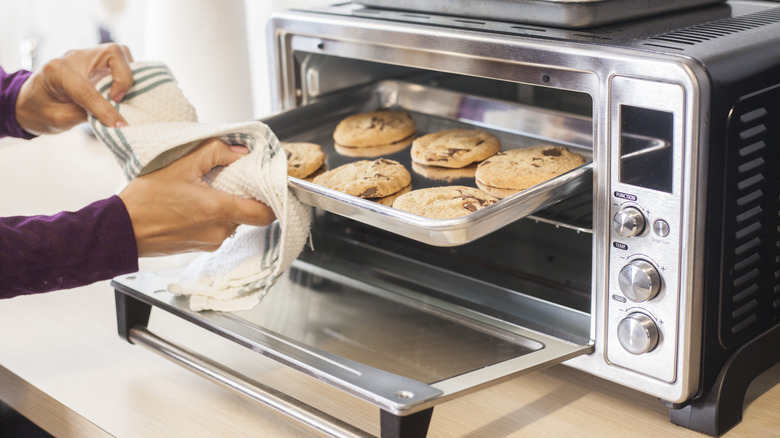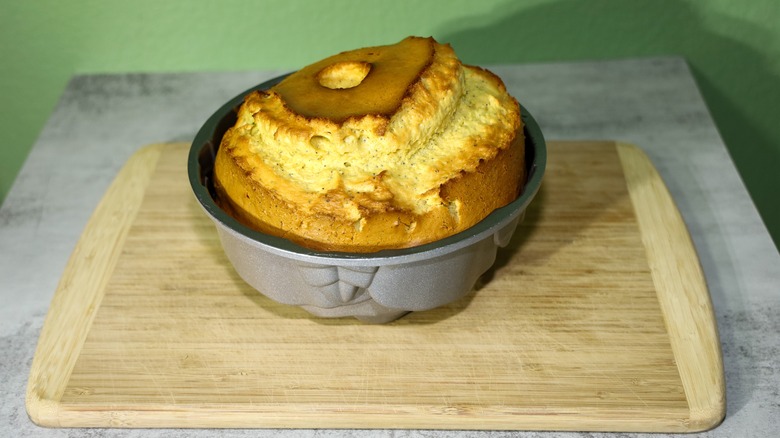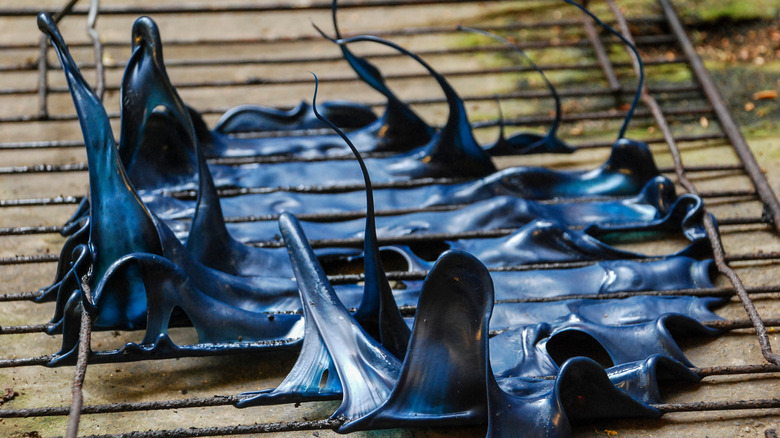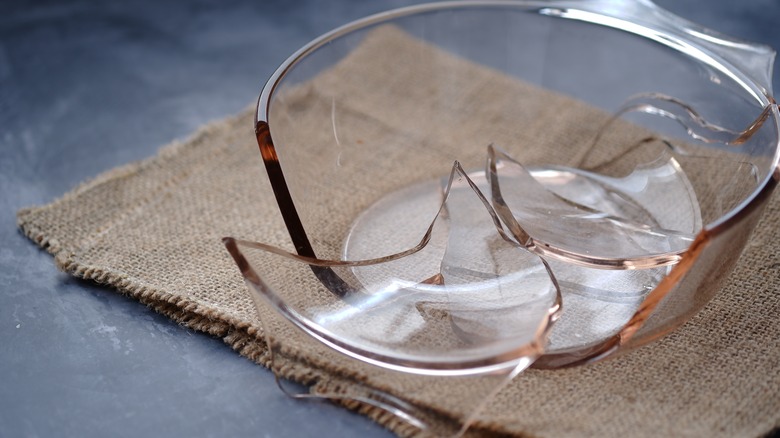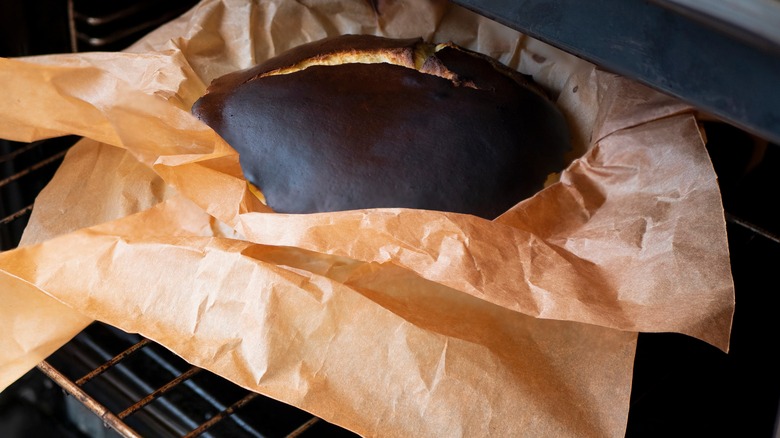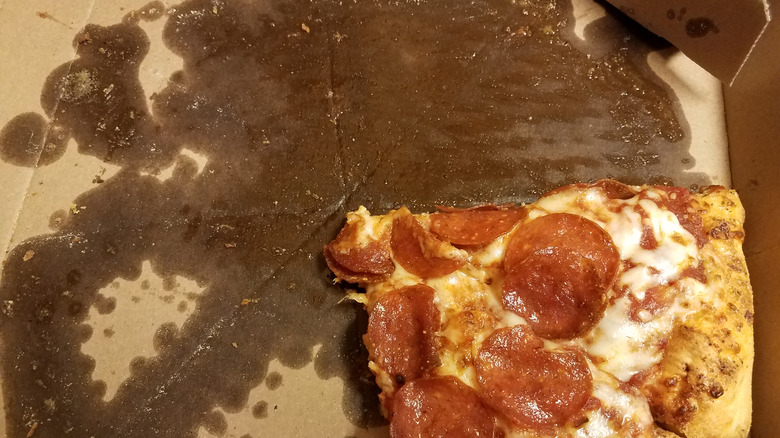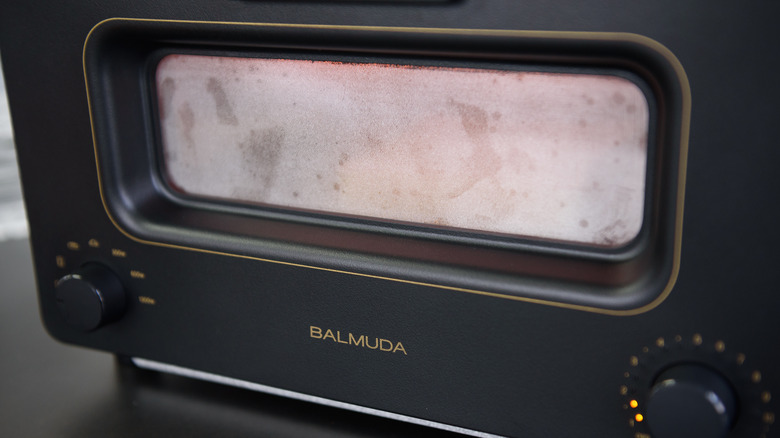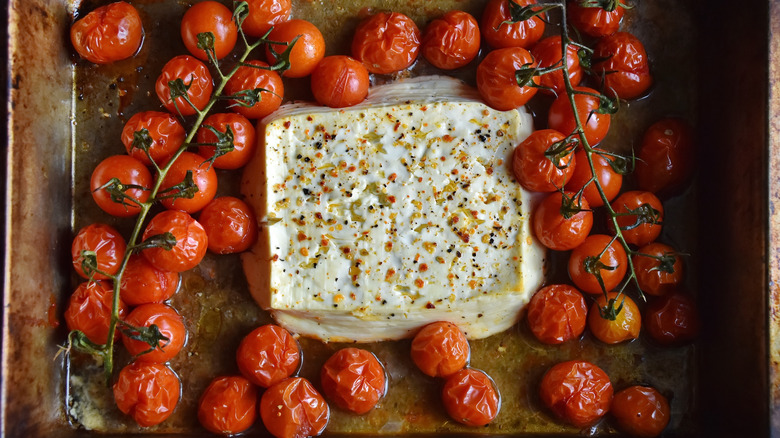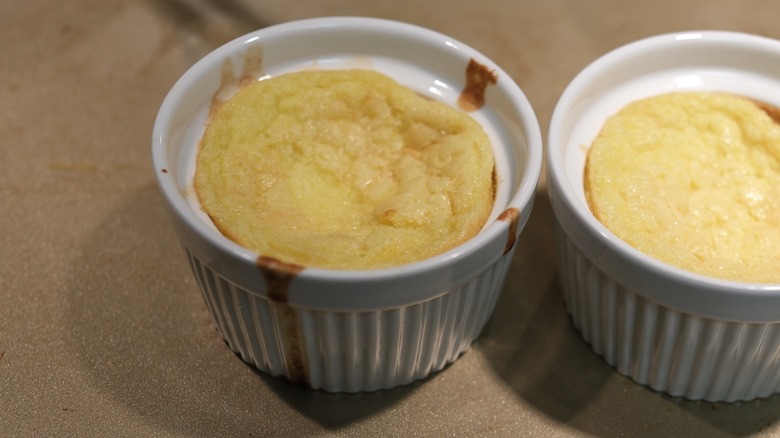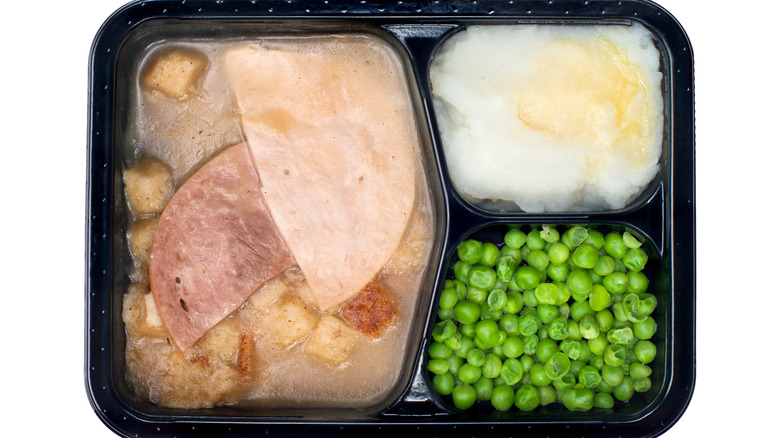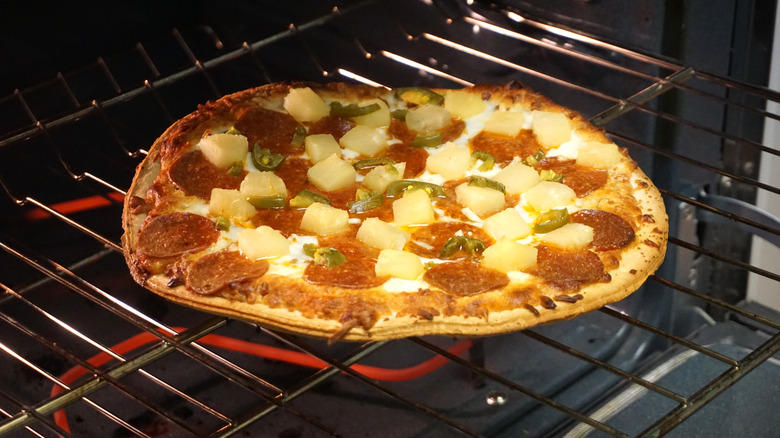Foods You Should Never Put In A Toaster Oven
Toaster ovens have proven themselves to be valuable not only for toasting thicker foods like bagels, but also for general cooking when you don't want to heat up your kitchen too much. However, they can't always be used just like your regular oven. Toaster oven heating elements sit very close to the food, and the entire oven can become very hot as you use it, meaning that fire is a real risk. You can reduce this risk, however, by using correct bakeware and knowing what it is about certain foods that could cause a problem.
One issue with toaster ovens is that they come in a wide range of sizes and configurations — everything from mini ovens that hold half a bagel to huge countertop ovens that include a rotisserie skewer for whole chickens. The interior size definitely influences what you can and can't cook in them, but some risks are universal. Before you get too worried about what could happen if you use the appliance wrong, read up on these foods you shouldn't put in a toaster oven.
Anything that will rise up close to or touch the upper heating element
Toaster ovens don't have nearly the vertical room inside them that you think they do. Larger toaster ovens may have a taller chamber, but the actual usable interior space still can be only a few inches tall. Much of the interior space is taken up by the two heating elements, and the rack has to rest above, and not on, the bottom element. That doesn't leave a ton of space for the pan and food.
Whatever you put in there has to be able to fit between the rack and the upper heating element, with at least one inch of space — if not more — between the food and the element. Food that's too close is a fire risk because it could burn easily, especially if it rises up and touches the element. Baking any breads or cakes that rise as they cook can be risky if you don't know how high they'll rise. One potential solution is to bake smaller portions, such as mini-loaves instead of a full-size loaf. However, the amount of rise really depends on the recipe and may require some careful testing and observation — not to mention fast reflexes if you see the food start to rise too close to the upper element. Don't leave that food unattended in the toaster oven.
Anything in a container that isn't oven-safe
Technically, an oven-safe container can go in a toaster oven, assuming it isn't touching the heating elements and so on. But it's not always easy to tell what's oven-safe. For example, some glass and ceramics may break from thermal shock, and some ceramic glazes aren't oven-safe. If you have a pile of glass or ceramic dishes from different manufacturers, it's easy to assume that because some of them survived being in the oven, all of them should survive, and that's not the case. Always check the label on the underside of your dishes before using them.
Plastic, paper (excluding some brands of parchment paper), and other non-oven-safe materials shouldn't go into a toaster oven. It's easy to forget that some of the TV dinners you have in your freezer use materials that aren't oven-safe. This doesn't always mean the food itself can't be cooked in a toaster oven. But if you're used to using a microwave for that food and now have to use a toaster oven, you can't pop the container in the oven because that can start a fire and/or melt the material. And if the box instructions say the dinner is safe for an oven but not a toaster oven, that's due to the proximity of the elements to the container and the resulting fire risk.
Anything in an oven-safe container that isn't able to take high heat
Oven-safe glass isn't necessarily toaster-oven-safe. The proximity of the heating element to the baking dish or tray in a toaster oven places a lot of heat stress on the material. That means that whatever you use has to survive that heat. Most glass bakeware isn't recommended for the intense temperatures of the toaster oven — it's not broiler-safe either. Similarly, when choosing ceramic bakeware for the toaster oven, you should check if it's broiler-safe — if it's not, it shouldn't be used in a toaster oven. Glass and ceramic can both potentially shatter if exposed to excessive heat in a toaster oven.
In addition, watch out for parchment paper. Depending on the brand, parchment paper is and isn't safe for toaster ovens. Check the box first and don't use parchment paper that carries a warning about not using it in a toaster oven.
Anything in foil or parchment paper that touches the sides or heating elements
Another issue you have to look out for is how close foil and parchment paper come to touching the sides of the oven or the heating elements. If parchment paper, even an oven-safe brand, gets near or touches the heating elements or the inside walls and door of the toaster oven, it can catch on fire. Those walls and doors get very hot, so never let the paper get near them. Ensure that the corners and edges of any parchment paper you use are contained within the pan.
As for foil, you'll find some advice online stating that you shouldn't use foil in a toaster oven, but that's not quite correct. Merely having foil in a toaster oven isn't bad; you can still line pans with it and wrap food in it before cooking. But letting the foil get near or touch the heating elements or the sides of the oven (door included) can make the foil melt. Never line the oven or crumb tray with foil as that can cause those sections to overheat, resulting in damage to the oven. If you wrap food up in foil for baking, place it on another baking sheet and not directly on the rack. If the foil rips, the baking sheet will catch anything that drips out of the packet and stop it from landing on the bottom heating element.
Anything that will spit out or drip excessive amounts of grease
Toaster ovens are great for heating up a quick batch of fries or a pizza, but you must be cautious with foods like these. Anything that can drip fat or splatter grease is — guess what — a fire risk. If grease hits the heating elements, it can burn, as well as cause a giant mess that's a pain to clean up. Anything that you think will result in melted fat or grease needs to be contained in some way, such as being wrapped up in a foil packet that you place on a baking sheet.
Pizza can be a tough food to deal with. On one hand, many toaster oven product descriptions include the size of pizza that you can fit into the oven, so you know that you can cook a pizza in there. However, pizzas often produce a lot of grease. If you're going to cook pizza in your toaster oven, place it on a pan, not the rack, and place the rack in the lowest position to ensure there is plenty of room between it and the upper heating element. Never walk away while it's cooking; keep a close eye on it. By the way, if the box says to never use a toaster oven, try to use a conventional oven for that pizza. You may find that pizza cooks unevenly in the toaster oven.
Anything that needs to be steamed in the oven
Steaming food isn't just a stovetop process; there are recipes that call for placing a tray of water below something that's cooking in an oven to create extra moisture. This can be done with any type of food, but it's very common in bread recipes. Adding steam keeps the crust a little softer during the first few minutes of baking, which allows the bread to rise more — a hard crust would prevent more expansion. And it's pretty much a no-go for most toaster ovens because they're just too small.
If you have one of those extra-large toaster ovens with several rack placement options, you might actually have the room for a small tray of water placed on a lower rack while food cooks on an upper rack — although liquid in a toaster oven is a dicey proposition, which we'll go into in a bit. Most conventional toaster ovens tend to be too short for this, however, and have very little space for multiple levels of trays. Remember, you can't place items on the crumb tray due to the potential for overheating and damage, and you should never, ever, place something on the lower heating element even if that element looks like it has a cover. One option you might consider if you want to bake bread in a toaster oven is to get a model that has a separate steam setting.
Liquid or liquid-filled dishes
Toaster ovens are relatively small and light. Pull the door open on one and you might see the entire oven move forward a little; models that are narrow but tall may even tip over. Normally that's not much more than an annoyance, but if you have anything cooking in there with a lot of liquid, it could turn into a mess. That little movement forward can be jolting enough to make liquid splash out of pans and spill onto the heating element and crumb tray.
Avoid cooking very liquidy dishes in the toaster oven; for example, don't try to cook soup or pasta in water in the toaster oven even if your stove is out of commission. Water-filled trays for steaming could be a bad idea even in bigger toaster ovens because of the risk of spills; if you're determined to use them, use a pan with high sides and keep the water level low. Just keep in mind that toaster ovens in general are better for foods with a lower moisture content.
Souffles and other things you can't disturb
Toaster ovens often have hot spots and cold spots. This results in unevenly cooked food and two-tone cake tops unless you rotate the pan or stir the food, and while convection may mitigate this somewhat, there's no guarantee that all convection models will cook evenly, either. Because you'll likely have to rotate pans, you don't want to make anything in the toaster oven that you can't disturb. The instructions in many souffle recipes say specifically to never open the door during cooking, and other recipes like airy cakes or sponge cakes sometimes don't do that well when disturbed either.
It's always a good idea to test your toaster oven when you first get it to determine where the uneven spots are and find out how many degrees hotter or colder they may be. You can do this by placing oven thermometers in the toaster oven and heating to a specific temperature (e.g., heating to 350 degrees Fahrenheit and seeing if the thermometer readings match that). Another method is to fill a tray with a single layer of bread slices, toast them, and see how evenly toasted all of them turn out to be.
Microwave-only TV dinners/meals
Many TV dinners or meals that can be cooked in a microwave can also be cooked in a toaster oven if you change the container to one that's oven-safe and find the appropriate cooking times and temperatures. However, some companies produce meals made for the microwave only. They're created with the way the microwave cooks in mind, and trying to cook them in a toaster oven won't work well. Parts of the food could be undercooked and unsafe to eat while other parts are overcooked, and the texture will be off. You could experiment if you want, but keep issues like heating element proximity and sauce splattering in mind and take appropriate precautions.
Reheating some foods can also be a challenge in the toaster oven. The microwave is terrific for reheating foods like stew and soup if you don't want to use the stove, but you can't really reheat those in a toaster oven; the appliance just isn't built to reheat liquidy food that well. Again, toaster ovens are better for foods with lower moisture content, and microwaves are better for foods with high moisture content.
Food without a drip tray
A lot of people like to place bagels, toast, and similar foods directly on a toaster oven's rack, thinking that food won't leave much of a mess. They'll even do that with pizza. If you're one of those people who just does not want to place the food on a pan because you want more air circulation around the food or you want grill marks, then place another tray under the rack to use as a drip pan. The racks in many oven models come with small underside brackets that can hold a smaller baking pan (usually the one included with the oven) as a drip pan.
Why would you need a drip pan for food on the rack? Because anything that falls off is at risk of hitting the lower heating elements. Even crumbs can result in a fire if you let too many of them build up. Removable crumb trays help, but they're not perfect, especially if they're awkward to remove. A bit of cheese can drip off that pizza, too, and land on the heating element. You're better off using pans, but if you're determined to use only the rack, add that drip pan underneath. And again, don't place the drip pan on the heating element because of the risk of fire and damage.
